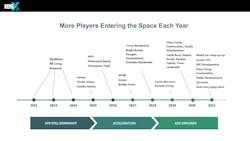5 Ways To Make Distinctive Build-to-Rent Housing Units
Many would-be homeowners want the experience of a single-family home, but without the expense and burden that come with owning one. Increasingly, they’ve been turning to the build-to-rent housing market.
“Build-for-rent has become extremely popular lately,” housing market economist Brad Hunter, practice leader at Hunter Housing Economics, said at NAHB’s virtual International Builders’ Show (IBSx) in February.
Build-to-rent unit numbers will continue to climb, Hunter predicted—from 60,000 new units last year to 100,000 next year.
There are some clear drivers behind this trend, he noted. Consumers want more space indoors and outdoors, as well as private parking, but they don’t always have the downpayment for a single-family home. And with home prices rising and housing supply dwindling, build-to-rent units—whether they’re single-family homes, townhomes, or horizontal (single-story) apartments—have been increasingly attractive.
Homebuilders and developers see the appeal, too. For one thing, single-family rents have been on the rise. And, as Hunter pointed out, build-to-rent tenants tend to stay longer than typical renters, which reduces one of the biggest costs in the rental business: tenant turnover.
But as the build-to-rent market attracts more players, you’ll have to distinguish your product from the rest. “Differentiate enough, and you’ll be less affected by the rising waves of competition,” Hunter said.
5 Ways Builders Can Create Distinctive Build-to-Rent Housing Units
Here are five ways builders and developers can distinguish their build-to-rent housing from the competition, according to Hunter and his IBSx co-presenter, Deryl Patterson, residential architect and president of Housing Design Matters.
1. Build-to-rent units have to be built to last. Over time, build-to-rent units will house a lot more residents and get a lot more foot traffic than units built to sell. They need to be made for durability.
On the exterior, that means using sturdy materials like brick or cementitious siding. On the interior, think about high-traffic areas like the bathroom. Use fiberglass tub enclosures or shower pans, and install large tiles in the showers to minimize the grout.
2. Build for the renters who will cause the most wear and tear: the four-legged tenants. Beware “the dog as the disrupter,” Patterson said. Building for people with pets requires careful thought about floor finishes. Use flooring, like luxury vinyl, that won’t reveal scratches from dogs’ paws or stains from their water bowls. Also, she said, “Carpet is your enemy in rentals.”
Think about dogs on the outside, too. With small, enclosed yards, take advantage of washable artificial grass specially designed for canine use.
3. It’s not just how much space your build-to-rent unit has—it’s how you use it. Build-to-rent units need to be built not just for more residents but for more movers, too. Consider the areas where large pieces of furniture will be hauled in and out, and build accordingly.
For instance, shorten the distance that large furniture has to travel by placing the primary bedroom near the top of the stairs. And allow enough space for movers to easily pivot a king-size bed into the bedroom, without bumping the walls.
Speaking of big beds: Renters who crave the single-family home experience will want a primary bedroom that can fit their king. So that room will need a wall that’s at least 13 feet long, according to Patterson.
“It’s important to think about not just square footage but what’s going in there,” she said.
4. Skip the costly customizations. Homebuyers expect customizations. Renters don’t. For builders, that translates into savings.
Whether you’re building for renters or for rental operators, they “don’t need or want all the upgrades you might be used to selling on the for-sale side,” Hunter said. “You can build an entire subdivision with the exact same features and no customization.”
Build-to-rent offers other savings and efficiencies. Trades quickly learn the construction product and process, and builders avoid costly broker commissions and homeowner warranty claims.
5. With build-to-rent, you’re not just constructing a home. You’re building a community. Build-for-rent units are not standalone residences. They’re part of a larger development. So builders should think about exterior finishes, landscaped yards, and attractive streetscapes.
“This is really important if you’re going into a community and perhaps NIMBYs there are saying, ‘Uh-uh, no rental stuff here,’” Patterson said. “Don’t just think about the individual houses, think about the entire community.”
For instance, renters might use garages not for their cars but for their storage. So you might install landscaping buffers to keep outdoor parking areas out of sight.
As Patterson noted: “It doesn’t have to be ugly just because it’s for rent.”


